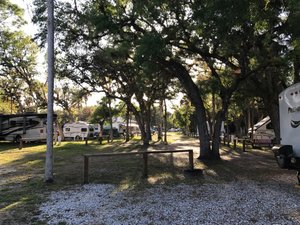Advertisement
Published: March 29th 2017

 IMG_0202
IMG_0202
Right from our CampsiteCollier Seminole State Park, Naples, Florida
Joan and I are both getting a little tired of the long drives. Fortunately, we have just about reached our furthest destination after putting in another180 miles yesterday going south out of St. Pete on Interstate 75 and skirting around some of the bigger cities on the Gulf coast of the Florida Peninsula, like Sarasota and Fort Myers.
We stopped for a good lunch at the coastal town of Punta Gorda. Ate a sidewalk table, with the dogs, at a place called Jack's on Marion. I had a delicious roast beef sandwich, Joan ate the grouper P'o Boy. Meals were good, but maybe not great. But it was a fairly easy to get there and there was a good place to park the rig across the street.
After getting back on the highway, we decided we were bored with the interstate scenery, so got off before Naples and took the Tamiami highway (US 41). The road gets its name because it was built by a guy named Collier a long time ago to connect Tampa and Miami. It was a lot slower because of dozens of traffic lights, seemingly timed to slow

 IMG_0201
IMG_0201
Relaxing After Setting Up Campus down, but it was pretty interesting. I can tell you that, based on the numbers of Maseratis, Beamers, Mercedes, and Vettes on the road, Naples seems to be the retirement heaven for rich folks. They even have luxury RV parks packed full of huge motor homes that do not appear to move for long periods of time.
We arrived at our campsite at a fairly reasonable time and it is going to be a beautiful place to spend the day. We have a pull-through on the corner, surrounded by tall trees providing ample shade. And the vegetation is, well, about as different as you can get and still be in the U.S. (More on that later.). We will be using this as our home base for a few days, so it is nice to have a good spot to come home to. This is also the place we are supposed to receive our new credit cards, hopefully later on today! Then I get to spend some time racking up cell-phone data dollars changing our on-line credit card numbers - Nice way to spend the day, don't you think!
I've recently become interested in how scientists define different

 IMG_0204
IMG_0204
All of My Girlsecological zones across the country. That interest eventually got me to the EPA web site where I discovered they have a very intricate zoning system in the works. It operates at four levels of detail, starting with a Level I zoning map that divides the continent up in fifteen zones based on obvious differences in terrain, vegetation, and wildlife. At Level II, each of those zones is further divided into 50 distinct areas, Level III is 182 zones, and Level IV is still being developed, but will have four or five hundred.
I decided to download as much of that information, especially the maps and zone descriptions as I could before the anti-science Repugnicans eliminate the agency and destroy all of its work. I've been finding it very interesting to look at these maps and descriptions as we travel across the country.
At Level I, for instance, almost the entire eastern half of the country is in zone 8, Eastern Temperate Forests. At Level II, Zone 8 is divided into five zones, three of which, we have visited on our trip. I referred to them as the Appalachian, the Piedmont, and the Atlantic Coastal Plain. They have different names under the EPA approach, but the definitions are about the same. At Level III, we would be traversing 9 different zones. And, believe me, the EPA has one page descriptions of each of them.
But the reason I brought this up at all has to do with the zone we are currently in, the Southern Florida Coastal Plain, also known as the Everglades. This zone is so unique that it exists nowhere else in the U.S. On the North American continent, only the Yucatán Peninsula in Mexico is considered similar as a Wet Tropical Forest. The EPA considers the area as virtually frost-free with tons of rainfall, but very little, if any, temperatures below freezing. It is about as flat as you can get so that even small elevation differences (a few feet) can have dramatic consequences in the ecology. It is covered in sawgrass marshes with scattered tree islands. Cypress trees are dominant in the western portions; gumbo, oaks, and palms in the central part (what we typically call 'The Everglades'; pine and palmetto on the Atlantic coastal areas (which is also where the population centers are); and mangrove trees along the southern coasts and islands. Wildlife includes alligators, crocodiles, panthers, deer, manatees, wood storks, ibis, herons, and pelicans.
Should be an interesting next few days! (17.1.21)
Advertisement
Tot: 0.176s; Tpl: 0.01s; cc: 12; qc: 45; dbt: 0.075s; 1; m:domysql w:travelblog (10.17.0.13); sld: 1;
; mem: 1.1mb








Mickey
non-member comment
FLAT
I'm looking forward to your Everglades,etc. posts.